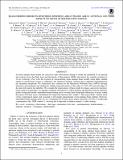BEAM-FORMING ERRORS IN MURCHISON WIDEFIELD ARRAY PHASED ARRAY ANTENNAS AND THEIR EFFECTS ON EPOCH OF REIONIZATION SCIENCE
Author(s)
Neben, Abraham Richard; Lonsdale, Colin John; McWhirter, Stephen R.; Williams, Christopher Leigh; Hewitt, Jacqueline N; Dillon, Joshua Shane; Cappallo, Roger J; Corey, Brian E; Goeke, Robert F; Morgan, Edward H; ... Show more Show less
DownloadNeben-2016-BEAM-FORMING ERRORS.pdf (10.48Mb)
PUBLISHER_POLICY
Publisher Policy
Article is made available in accordance with the publisher's policy and may be subject to US copyright law. Please refer to the publisher's site for terms of use.
Terms of use
Metadata
Show full item recordAbstract
Accurate antenna beam models are critical for radio observations aiming to isolate the redshifted 21 cm spectral line emission from the Dark Ages and the Epoch of Reionization (EOR) and unlock the scientific potential of 21 cm cosmology. Past work has focused on characterizing mean antenna beam models using either satellite signals or astronomical sources as calibrators, but antenna-to-antenna variation due to imperfect instrumentation has remained unexplored. We characterize this variation for the Murchison Widefield Array (MWA) through laboratory measurements and simulations, finding typical deviations of the order of ±10%–20% near the edges of the main lobe and in the sidelobes. We consider the ramifications of these results for image- and power spectrum-based science. In particular, we simulate visibilities measured by a 100 m baseline and find that using an otherwise perfect foreground model, unmodeled beam-forming errors severely limit foreground subtraction accuracy within the region of Fourier space contaminated by foreground emission (the "wedge"). This region likely contains much of the cosmological signal, and accessing it will require measurement of per-antenna beam patterns. However, unmodeled beam-forming errors do not contaminate the Fourier space region expected to be free of foreground contamination (the "EOR window"), showing that foreground avoidance remains a viable strategy.
Date issued
2016-03Department
Haystack Observatory; Massachusetts Institute of Technology. Department of Physics; MIT Kavli Institute for Astrophysics and Space ResearchJournal
The Astrophysical Journal
Publisher
iop
Citation
Neben, Abraham R., Jacqueline N. Hewitt, Richard F. Bradley, Joshua S. Dillon, G. Bernardi, J. D. Bowman, F. Briggs, et al. “BEAM-FORMING ERRORS IN MURCHISON WIDEFIELD ARRAY PHASED ARRAY ANTENNAS AND THEIR EFFECTS ON EPOCH OF REIONIZATION SCIENCE.” The Astrophysical Journal 820, no. 1 (March 17, 2016): 44. © 2016 The American Astronomical Society
Version: Final published version
ISSN
1538-4357
0004-637X